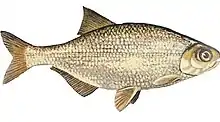| Halecostomi | |
|---|---|
 | |
| Amia calva (bowfin) | |
 | |
| Hiodon tergisus | |
| Scientific classification | |
| Domain: | Eukaryota |
| Kingdom: | Animalia |
| Phylum: | Chordata |
| Class: | Actinopterygii |
| Subclass: | Neopterygii |
| (unranked): | Halecostomi Regan, 1903 |
| Subdivisions | |
Halecostomi is the name of a group of neopterygian fish uniting the halecomorphs (represented by the living bowfin and many extinct groups) and the teleosts, the largest group of extant ray-finned fish.[1]

The Halecostomi hypothesis and the Holostei hypothesis are two competing hypotheses explaining the evolutionary relationships of living ray-finned fish. The Holostei hypothesis is better supported, rendering the Halecostomi a paraphyletic group (i.e., rejecting the Halecostomi hypothesis).[2][3][4][5]
The Holostei hypothesis posits that Ginglymodi (gars and their fossil relatives) and Halecomorphi form a clade, called Holostei, and that the Holostei are the sister group to the Teleostei.
| Neopterygii |
| ||||||||||||
References
- ↑ Patterson C. Interrelationships of holosteans. In: Greenwood P H, Miles R S, Patterson C, eds. Interrelationships of Fishes. Zool J Linn Soc, 1973, 53(Suppl): 233–305
- ↑ Grande, Lance; Bemis, William E. (1998). "A Comprehensive Phylogenetic Study of Amiid Fishes (Amiidae) Based on Comparative Skeletal Anatomy. an Empirical Search for Interconnected Patterns of Natural History". Journal of Vertebrate Paleontology. 18 (sup001): 1–696. Bibcode:1998JVPal..18S...1G. doi:10.1080/02724634.1998.10011114.
- ↑ López-Arbarello, Adriana; Sferco, Emilia (March 2018). "Neopterygian phylogeny: the merger assay". Royal Society Open Science. 5 (3): 172337. Bibcode:2018RSOS....572337L. doi:10.1098/rsos.172337. PMC 5882744. PMID 29657820.
- ↑ Betancur-R (2016). "Phylogenetic Classification of Bony Fishes Version 4".
- ↑ Nelson, Joseph, S. (2016). Fishes of the World. John Wiley & Sons, Inc. ISBN 978-1-118-34233-6.
{{cite book}}: CS1 maint: multiple names: authors list (link)
.jpg.webp)